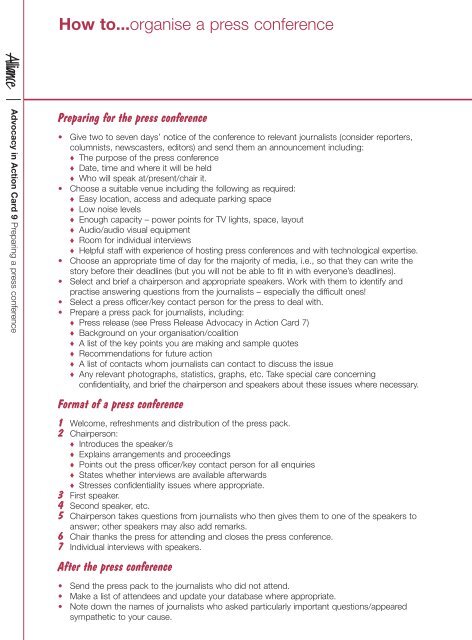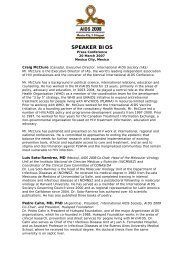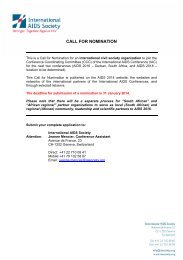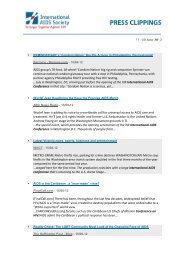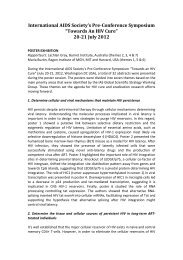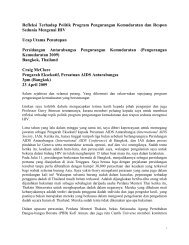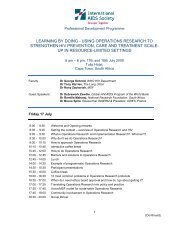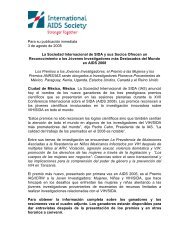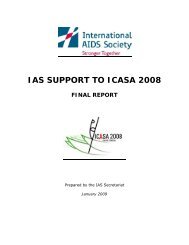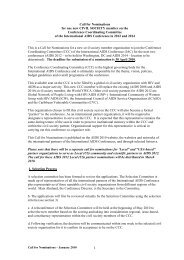Advocacy in Action - International AIDS Society
Advocacy in Action - International AIDS Society
Advocacy in Action - International AIDS Society
You also want an ePaper? Increase the reach of your titles
YUMPU automatically turns print PDFs into web optimized ePapers that Google loves.
How to...organise a press conference<br />
<strong>Advocacy</strong> <strong>in</strong> <strong>Action</strong> Card 9 Prepar<strong>in</strong>g a press conference<br />
Prepar<strong>in</strong>g for the press conference<br />
• Give two to seven days’ notice of the conference to relevant journalists (consider reporters,<br />
columnists, newscasters, editors) and send them an announcement <strong>in</strong>clud<strong>in</strong>g:<br />
♦ The purpose of the press conference<br />
♦ Date, time and where it will be held<br />
♦ Who will speak at/present/chair it.<br />
• Choose a suitable venue <strong>in</strong>clud<strong>in</strong>g the follow<strong>in</strong>g as required:<br />
♦ Easy location, access and adequate park<strong>in</strong>g space<br />
♦ Low noise levels<br />
♦ Enough capacity – power po<strong>in</strong>ts for TV lights, space, layout<br />
♦ Audio/audio visual equipment<br />
♦ Room for <strong>in</strong>dividual <strong>in</strong>terviews<br />
♦ Helpful staff with experience of host<strong>in</strong>g press conferences and with technological expertise.<br />
• Choose an appropriate time of day for the majority of media, i.e., so that they can write the<br />
story before their deadl<strong>in</strong>es (but you will not be able to fit <strong>in</strong> with everyone’s deadl<strong>in</strong>es).<br />
• Select and brief a chairperson and appropriate speakers. Work with them to identify and<br />
practise answer<strong>in</strong>g questions from the journalists – especially the difficult ones!<br />
• Select a press officer/key contact person for the press to deal with.<br />
• Prepare a press pack for journalists, <strong>in</strong>clud<strong>in</strong>g:<br />
♦ Press release (see Press Release <strong>Advocacy</strong> <strong>in</strong> <strong>Action</strong> Card 7)<br />
♦ Background on your organisation/coalition<br />
♦ A list of the key po<strong>in</strong>ts you are mak<strong>in</strong>g and sample quotes<br />
♦ Recommendations for future action<br />
♦ A list of contacts whom journalists can contact to discuss the issue<br />
♦ Any relevant photographs, statistics, graphs, etc. Take special care concern<strong>in</strong>g<br />
confidentiality, and brief the chairperson and speakers about these issues where necessary.<br />
Format of a press conference<br />
1 Welcome, refreshments and distribution of the press pack.<br />
2 Chairperson:<br />
♦ Introduces the speaker/s<br />
♦ Expla<strong>in</strong>s arrangements and proceed<strong>in</strong>gs<br />
♦ Po<strong>in</strong>ts out the press officer/key contact person for all enquiries<br />
♦ States whether <strong>in</strong>terviews are available afterwards<br />
♦ Stresses confidentiality issues where appropriate.<br />
3 First speaker.<br />
4 Second speaker, etc.<br />
5 Chairperson takes questions from journalists who then gives them to one of the speakers to<br />
answer; other speakers may also add remarks.<br />
6 Chair thanks the press for attend<strong>in</strong>g and closes the press conference.<br />
7 Individual <strong>in</strong>terviews with speakers.<br />
After the press conference<br />
• Send the press pack to the journalists who did not attend.<br />
• Make a list of attendees and update your database where appropriate.<br />
• Note down the names of journalists who asked particularly important questions/appeared<br />
sympathetic to your cause.


